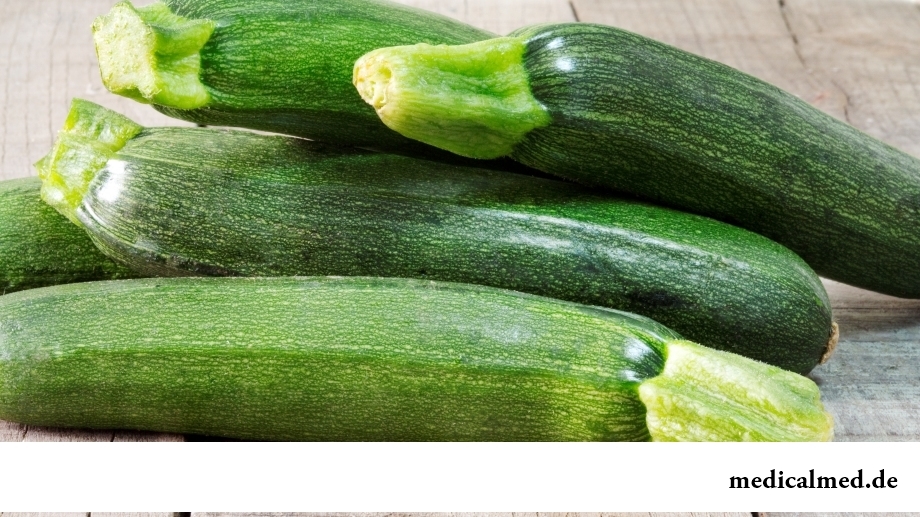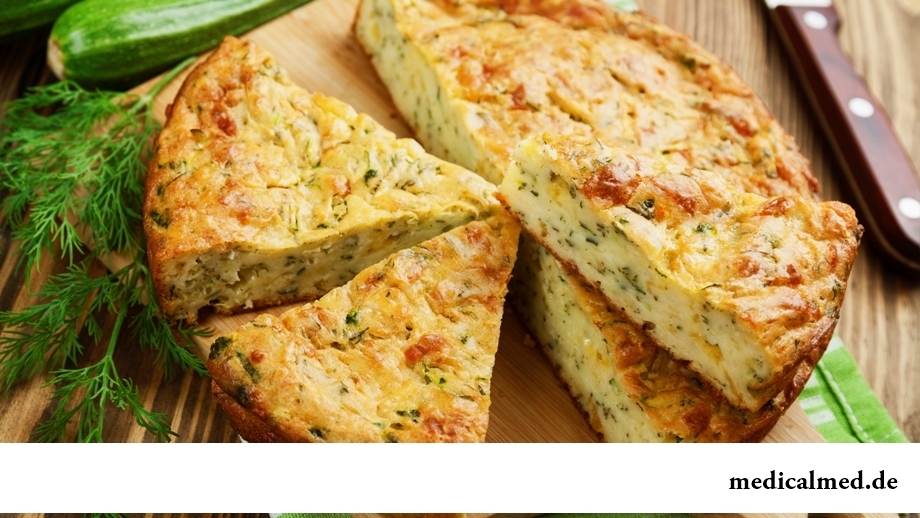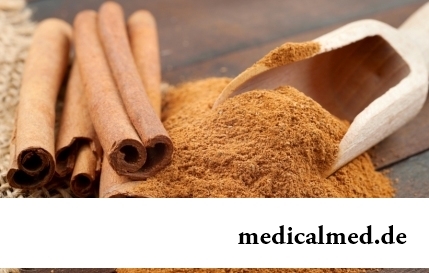





Zucchini
Zucchinis in the people call "the Italian vegetable marrow". It is tasty vegetable which is very easily acquired by an organism, and thanks to the low caloric content of zucchini include in structure of many diets.

Description
Zucchini - an annual herbaceous plant of family Pumpkin, subspecies of pumpkin ordinary. Externally it represents a vegetable marrow of an oblong cylindrical shape. At this zelenoplodny vegetable pulp more gentle, having the watery, softly expressed taste, and the thin skin grows coarse not too quickly, as at the fellow of a vegetable marrow. Therefore at zucchini the period of technical ripeness is extended, and its useful properties and food qualities remain longer. Color of a peel can be yellow, is dark or pale green. Young fruits up to 15 cm in size can be used quietly in the raw together with a peel. It is considered that these fruits the most tasty and valuable. At larger fruits pulp more rough, and a peel – firmer.
The plant represents a compact bush which suits for cultivation even on a balcony. Leaves are not prickly, slaboopushenny. The plant forms preferential flowers of a feminine gender therefore also productivity at it is higher. Besides, zucchini – early vegetable. Ripe fruits are well stored and can easily lie at the room temperature up to the following harvest.
History
Zucchinis were known in America in antique times. Archeologists found to it confirmation. In this country vegetable marrows grew up in the 3rd millennium B.C., however locals long considered plant fruits inedible and ate only its seeds.
In the 16th century from the New World together with other wonders of zucchini got to Europe. Initially people even did not represent that its fruits can be eaten, and used as an adornment plant, growing up in botanic gardens, but its flowers considered edible. In the 18th century in Italy fruits of vegetable marrows began to eat and till today it is difficult to imagine the Mediterranean kitchen without zucchini and vegetable marrows.
Useful properties of zucchini
Thanks to the useful properties vegetable marrows are just irreplaceable product for treatment, prevention and improvement of a human body. Vegetable marrows improve secretory and motor functions of intestines and stomach, activate digestion processes.
Because of the high content of ascorbic acid of zucchini has fortifying properties, and the pectinaceous substances which are its part promote easy comprehensibility of fruits of a plant. Besides, fruits of zucchini possess diuretic action, bring excesses of water, sodium salt, heavy metals and toxins therefore marrow caviar is very useful at gout, an urolithiasis, nephrite, chronic pyelonephritis and disbolism out of an organism.
It is useful to use zucchini dishes at atherosclerosis, hepatitis, a hypertension, cholelithiasis, cholecystitis.
As zucchini contains not enough cellulose, they are excellent food for the patients who recently underwent intestines or stomach operations. Also it will be useful for the people who are recovered after poisoning to keep to a marrow diet. And thanks to the low caloric content of zucchini will be very useful to the people aiming at decrease in body weight. There are even interesting marrow diets created especially for the people having obesity.
Thanks to useful properties the regular use of zucchini improves a condition of skin, nails and hair, and also teeth and sight.
Zucchinis at cardiovascular diseases, an ulcer of a 12-perstny gut, an anemia are useful. People at whose diet there is a vegetable marrow till the old age remain healthy, light on the feet and mobile. Zucchinis are useful to all: for children, adults, elderly, nursing mothers.
Structure and caloric content of zucchini
In 100 g of zucchini 92,7 g of water, 2,7 g of proteins, 1,1 g of cellulose, 1,05 g of ashes, 2 g of carbohydrates, 0,4 g of fats contain; vitamins: beta carotene (A), thiamin (B1), Riboflavinum (B2), Niacinum (RR), pantothenic acid (B5), pyridoxine (B6), folic acid (B9), ascorbic acid (C); macrocells: phosphorus, sodium, magnesium, calcium, potassium; microelements: zinc, manganese, selenium, copper, iron.
Caloric content of zucchini makes 21 kcal on 100 g of a product.
Zucchini in cookery
When using in zucchini cookery preferential subject to thermal treatment. They are extinguished together with meat and vegetables, fried, used as a garnish to potatoes or rice dishes. Especially they tasty in a fried view with sauce from mayonnaise and garlic. From stewed zucchinis cook tasty snack under the name "marrow caviar". As it was already written above, young people, yet not absolutely dozrely fruits of a plant, it is possible to use in the raw, having small cut or having grated.
Do the marrow fritters having gentle juicy taste of small polished fruits. And absolutely small fruits are fried entirely together with a peel – very unusual and tasty dish turns out. All know such popular food as the stuffed zucchinis. Also they are preserved and pickled as a part of vegetable salads or separately. From zucchini even cook jam.

Zucchini is perfectly combined with parmesan and a thyme. Thanks to easy digestibility and low caloric content of zucchini children and adults can use though every day. They are especially useful in a daily diet of the people having problems with digestion. As a part of vegetable marrows there is a large amount of clear water that helps to reduce hypostases, bringing out of an organism excess liquid.
You should not prepare vegetable marrows too long, otherwise they lose not only the unique taste, but also the useful qualities.
Contraindications
Zucchinis at diseases of the kidneys tied with disturbance of a conclusion of potassium from an organism are contraindicated.
Average life expectancy of lefthanders is less, than right-handed persons.

Not everyone can brag of the shining Hollywood smile. Even at the person who is regularly visiting the stomatologist and watching з...
Section: Articles about health
Ayurveda - the most ancient tselitelsky practice which came to us from India. It represents the doctrine about maintenance of physical, psychological and moral health of the person by means of the complex of procedures including a diet, cleaning of an organism, respiratory упр...
Section: Articles about health
The depression not without reason is considered one their main troubles of our century: for scientific and technical progress, acceleration of rate of life and a surplus of information of people it is forced to pay with stresses, negative emotions and weakening of protective forces of an organism. As a result widely the states which are characterized by the increased uneasiness, falling of interest in life, spiritual and physical discomfort extend....
Section: Articles about health
Tick-borne encephalitis – one of the most dangerous viral diseases which causative agents transfer and is given to people by ixodic mites. Эт...
Section: Articles about health
The saying "the rich do not know how the other half lives" is known to all. In a broad sense it is that we can not always understand the person whose features of a state are unknown to us. If with physiological characters of diseases the situation is more or less clearly (having noticed and...
Section: Articles about health
The cosmetics intended for improvement of a condition of skin, nails and hair are used by each woman. Expenses on regular acquisition of the fashionable widely advertized products of well-known companies for many become very notable and significantly burden the family budget. Meanwhile, there is a number of inexpensive pharmaceutical drugs which can quite be applied in the cosmetic purposes. At the same time the effect of their use is often more noticeable, than result of use of the most expensive...
Section: Articles about health
Frosty air, fresh wind and easy snowball at most of Russians are associated with cheerfulness, health and cheerful entertainments, on to...
Section: Articles about health
The kid who was recently born is surrounded with love of adult family members and their cares without which the baby cannot exist. Some parents consider that gentle attachment and caress are quite enough that the child correctly developed and was happy...
Section: Articles about health
Small appetite at the child – the complaint which pediatricians should hear practically from each mother. Most often it is carried to the category of children's whims, however the refusal of food in certain cases can be to alarming symptoms therefore it cannot be ignored....
Section: Articles about health
The modern person not always manages to find housing in the environmentally friendly region and such work which would not do harm здо...
Section: Articles about health
The way of life of people promptly changes from year to year: if about ten years ago the personal computer was not in each family, then today already very few people do without this device. Certainly, and children master the computer at full speed: they not only I play...
Section: Articles about health
The fatigue, sleep debt, disturbances of food, bad mood, vagaries of the weather – all these circumstances badly affect our appearance. Especially the person suffers: skin becomes flabby, loses healthy color, becomes covered by wrinkles, zones of hypostases and dark circles under eyes appear. It is not always possible to be saved from influence of aggressive factors, but we are quite able to minimize its effects. For this purpose usually apply the cosmetics and procedures helping увлаж...
Section: Articles about health
Childbirth is the most important event in life of each woman. We are women we give birth to the new little man on this light. Now...
Section: Articles about health
Nightmares belong to the most unpleasant frustration. Statistically, they happen at 4% of adults, and almost at 70% of children and teenagers. During a nightmare of people dreams himself in extremely difficult, life-threatening situation. It wakens suddenly, in...
Section: Articles about health
All are familiar with cold, and practically everyone believes that he has sufficient knowledge and experience that correctly to treat it. In practice most of people makes mistakes in attempts to get rid of rhinitis, and divides numerous delusions it....
Section: Articles about health
All got used long ago that, having addressed the plastic surgeon, it is possible to modify natural parameters of a figure or to reduce...
Section: Articles about health
Heart disease and blood vessels lead to disturbance of blood supply of bodies and fabrics that involves failures in their work, deterioration in health of the person, decrease in its working capacity and standard of living. Annually such perishes from pathologies more...
Section: Articles about health
In consciousness of our many compatriots idea that folk remedies if are no more effective, than medicinal "chemistry" strongly took roots, then are precisely less harmful. Unfortunately, it is not always fair: some methods of treatment consecrated with "century national experience" can work so on the patient that it will need urgent intervention of physicians....
Section: Articles about health
Within several decades of our compatriots convinced that the use of butter nasty affects on...
Section: Articles about health
Phobia – the persuasive fear of a certain contents shown in a specific situation against the will of the person. Concepts of a phobia and fear are similar, however if the fear is natural protective function of mentality, then the phobia is its deviation. So the person can an ispytyva...
Section: Articles about health
Bathing in broths of medical flowers and plants (phytobathtub) was eurysynusic since Cleopatra who is a good judge in all that concerns beauty and health. And today phytobathtubs is the simple and available means allowing not only to remove nervous tension, but also to recover from many diseases. Grass bathtubs at treatment of cold, osteochondrosis, radiculitis, skin diseases, and also diseases of urinary tract and vessels are especially effective....
Section: Articles about health
Each person has easy indispositions which he transfers "standing", trying not to ask for medical care. Argu...
Section: Articles about health
(Xerostomia) many people consider feeling of a xerostomia small and easily removable inconvenience. This delusion: the symptom can demonstrate existence of serious diseases. It is worth to remember also that saliva performs important functions...
Section: Articles about health
Physical activity is necessary for normal functioning of a human body. At a lack of the movement joints cease to function, muscles atrophy, cardiovascular activity is broken and the metabolism worsens. The modern city rhythm of life does not provide the person with an adequate exercise stress, additional - sport is necessary. Tedious tasks the huge number of the people having those or ин exists sport not all to liking, but also...
Section: Articles about health
Cellulitis - very widespread cosmetic shortcoming which arises approximately at 80% of women sooner or later. Emergence ег...
Section: Articles about health
Sometimes it seems that modern society was divided into two camps: representatives of the first are sure that only the woman has to be responsible for contraception, representatives of the second, respectively, are sure that it is destiny of men. Meanwhile Dov has a question of contraception...
Section: Articles about health
Traveling all over the world, many try to try the most exotic dishes of national cuisines. There is even a so-called gastronomic tourism which, according to gourmets, not only allows to receive new feelings, but also is capable to show life of other people from absolutely unexpected side....
Section: Articles about health
